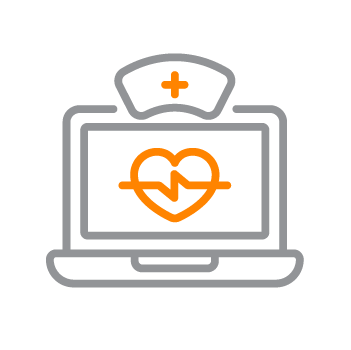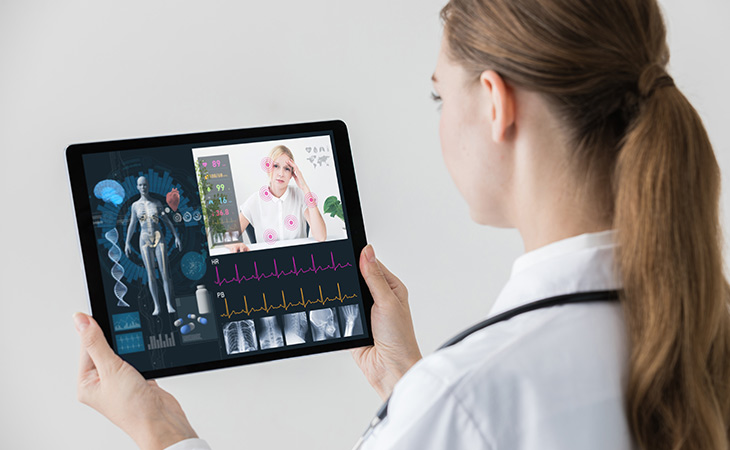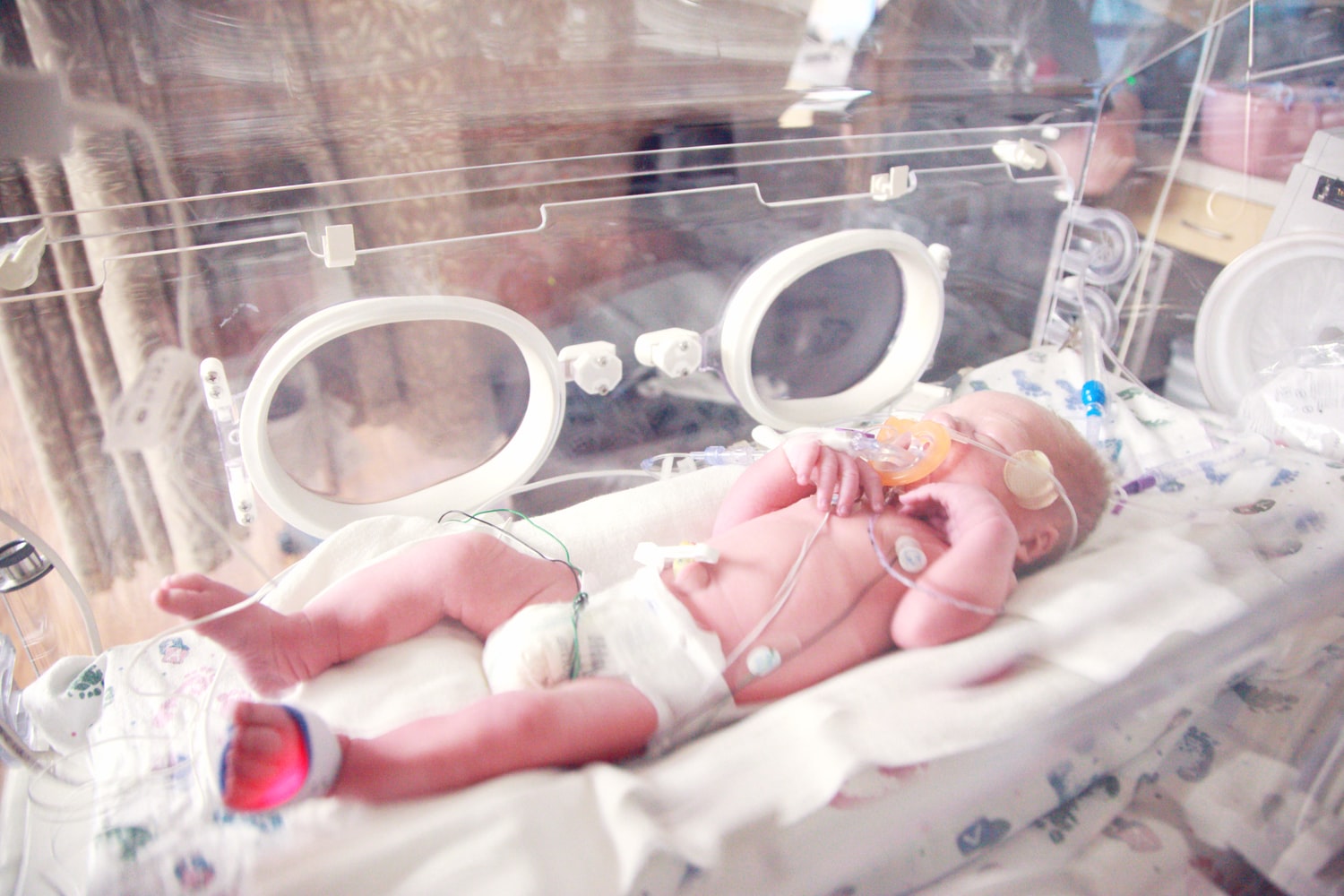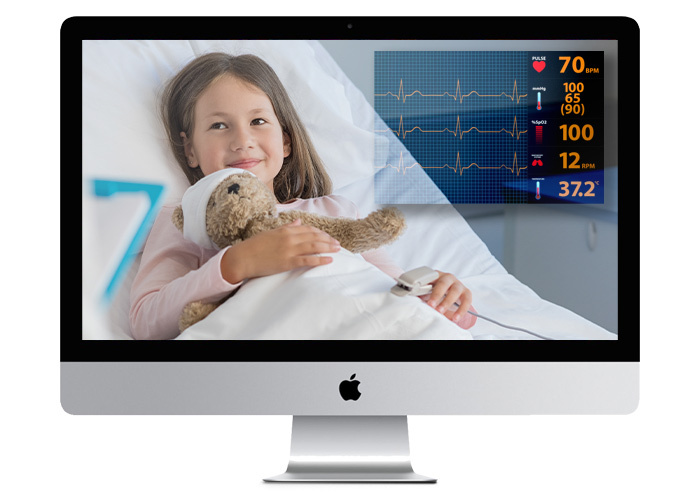10 Healthcare Trends for 2021

Curious what’s next in healthcare? Read on for our full take, or navigate to the healthcare trend of your choosing via the interactive table of contents below.
Introduction
Over the course of 2020, the COVID-19 pandemic shined a spotlight on the healthcare industry. Between Fauci’s pleas for social distancing and the global race for vaccinations, never before has the world been so singularly focused on one segment of our economy.
2020 was also the year that I became a mother. And thus, the medical sector took center stage in my own life. I watched from front row as standard doctor-patient practices evolved at a rapid pace.
What started as ‘temporary’ restrictions to bringing my husband to ultrasounds eventually took the form of explicit instructions from the ultrasound technician to live stream the appointment. By the time my daughter entered this world, conducting one of her early consultations over a video call felt both natural and effective.
But there were other aspects of the healthcare system that continued to frustrate me. For instance, why couldn’t I find any consensus from practitioners on official recommendations for limiting my newborn’s exposure?
This all culminated in mid-November when our entire family came down with coronavirus. Initially, my COVID-positive husband quarantined in the basement, while I cared for baby Luella upstairs, masked-up. We spent those early days video chatting on our phones and ordering medication via contactless delivery. Tracking down a test for myself and my daughter proved nearly impossible, and the advice I got from the doctor who finally diagnosed me as positive — to drink lemon juice mixed with baking soda — appeared to be another source of differing opinions in the field.
While my own experience last year was unique, several overarching aspects of it were felt on a global scale. For one, mixed messaging and misinformation about COVID-19 best practices have proliferated. This lack of clear direction, combined with an overtaxed system, has resulted in a growing distrust of healthcare at large.
But the qualms that many have had with the medical field aren’t without recourse. If 2020 proved anything, it’s the potential for technology to overcome the obstacles we continue to face. For this reason, tech will be the defining characteristic of healthcare’s transformation in 2021.
Without further ado, here’s our list of the top ten healthcare trends for 2021.
2021 Healthcare Tech Trends
- Transparent Patient-Doctor Communication
- Telehealth and Virtual Services
- Wearable Devices and the Internet of Medical Things (IoMT)
- Remote Patient Monitoring
- Public Health Surveillance and Smart Ecosystems
- Digitalization of Medical Supply Chains
- Next-Generation 911 Technologies
- Interprofessional Collaboration
- Revamping Elderly Care and Long-Term Care Facilities
- Augmented Reality (AR) and Virtual Reality (VR)
1. Transparent Patient-Doctor Communication
David Leonhardt of The New York Times writes:
“Early in the pandemic, many health experts — in the U.S. and around the world — decided that the public could not be trusted to hear the truth about masks. Instead, the experts spread a misleading message, discouraging the use of masks… [This] confused people. (If masks weren’t effective, why did doctors and nurses need them?) It delayed the widespread use of masks (even though there was good reason to believe they could help). And it damaged the credibility of public health experts…
Now a version of the mask story is repeating itself — this time involving the vaccines. Once again, the experts don’t seem to trust the public to hear the full truth.”
What’s the old saying? Oh yeah: Fool me once; shame on you. Fool me twice; shame on me.
The pandemic has revealed just how important it is for medical professionals to provide full transparency to their patients. Unlike twenty years ago, people will seek out the information they aren’t getting from their doctors by digging around online. They will also search for a new provider if they feel that their needs aren’t being met. For these reasons, communicating all of the facts from the get-go is in both the patient’s and doctor’s best interest.
The healthcare industry has got a long way to go in regaining the public’s trust — but transparent, two-way communication is a good place to start. Patient portals with access to medical records, ongoing dialogue from physicians, and patient education classes can all help empower the public.
Many organizations are broadcasting educational courses online to reach a larger viewer base and facilitate social distancing. I, myself, have watched countless live and on-demand streams over the past six months on everything from infant CPR and nursing to baby-led weaning and sleep training. Because many of these courses were offered by the very hospital that I gave birth at, taking them helped grow my relationship with the clinic — and by extension, my medical team.
2. Telehealth and Virtual Services
One surefire way to boost communication between doctors and patients is to improve accessibility for both parties. Telehealth, or the use of technology to remotely diagnose and treat patients, does just that.

After lagging behind for so long, telehealth finally transformed into a common and cost-effective alternative to going to the doctor’s office in 2020. Part of this was out of necessity. Federal officials temporarily waived certain HIPAA violations for “good faith use of telehealth” when the pandemic initially took hold. From there, both private and public health plans expanded coverage to include virtual care.
Telehealth isn’t just limited to run-of-the-mill physical ailment either. Today, fields as diverse as addiction treatment, therapy, and plastic surgery have all made the transition to virtual visits where possible.
As more insurers and patients embrace virtual visits, we predict that telehealth will continue to thrive. Why? The convenience of a virtual doctor visit simply can’t be disputed. Beyond that, video streaming brings skilled doctors to rural populations in the most affordable manner possible.
While telehealth appointments don’t always paint a complete picture due to lacking insight into vitals or lab work, remote patient monitoring devices and wearables will help overcome these obstacles in the near future.
3. Wearable Devices and the Internet of Medical Things (IoMT)

An estimated 20-30 billion IoMT devices are in use today.1
Healthcare IoT is a vast category, with plenty of overlap throughout this list. Everything from camera-aided surgical devices and smart monitors to nonsurgical robotics and digital kiosks makes up the Internet of Medical Things (IoMT).
In hospital settings, meal deliveries, disinfection routines, and specimen transportation will all eventually be delegated to these intelligent machines. Approximately 60 percent of healthcare organizations have already adopted healthcare IoT — the benefits of which are cost savings, greater visibility, and improvements to the customer experience.
But IoMT extends way past the hospital doors. Wearable devices are primed to revolutionize the space. Going beyond Fitbit, wearables of the future will enable the sharing of real-time health metrics such as blood pressure, temperature, heart rate, sleep cycles, respiration rate, and more.
Whether taking the form of a sock, headband, or bracelet, wearable technology is putting those of us without medical degrees in charge of our health. It also gives practitioners a more comprehensive view of what’s going on outside of the clinic.

4. Remote Patient Monitoring
Although many of the wearables discussed above fall in the business-to-consumer (B2C) category, remote patient monitoring devices are also being used within hospital settings. Child Health Imprints, for instance, built video into a cloud-hosted appliance for neonates. Their iNICU system assimilates real-time data from the disparate biomedical devices used to monitor preterm infants — including ventilators, monitors, and blood gas analyzers. In addition to reducing time-to-treatment and improving quality of care, the product enables remote monitoring of neonates in rural regions.
Similarly, AngelEye Health allows families to keep an eye on their newborn baby while being cared for in the neonatal intensive care unit (NICU). The around-the-cloud live video tool gives new parents the flexibility to see and communicate with their babies from outside of the hospital.

During COVID-19 and after, these remote patient monitoring solutions deliver major advantages. For one, physical proximity is no longer a barrier to healthcare. Remote monitoring also helps keep more vulnerable populations outside of contaminated hospital settings and digitally mobilizes medical resources.
5. Public Health Surveillance and Smart Ecosystems
From smart hospitals to smart cities, 5G connectivity and video streaming will collide to create intelligent ecosystems equipped with real-time surveillance technology in 2021.
Surveillance already plays a role in hospital environments. Thermal cameras pointed at entryways help detect those with an elevated body temperature, and live video feeds allow practitioners to monitor patients from the nurses’ station.
The combination of artificial intelligence (AI) and machine learning (ML) technologies with video surveillance will bring about expanded use cases. Smart surveillance solutions could be used to detect unusual behavior such as a patient fall, and the integration of interactive video would enable nurses to respond to patients with greater urgency.
#HealthIT leaders: Which surveillance tool would most improve the #PhysicalSecurity of your #healthcare facility?
— HealthTech Magazine (@HealthTechMag) October 12, 2020
The COVID-19 crisis has also uncovered a need for better contact tracing and monitoring technologies at the municipal level. Although the ethics of this tactic requires a larger discussion, it’s clear that an overhaul of old-school government technology systems is overdue. It’s high time that syndromic surveillance, or the automation of public health data analysis, replaces the faxed paper forms that we’re still relying on today.
6. Digitalization of Medical Supply Chains
The fragility of supply chains became apparent over the course of 2020, with personal protective equipment (PPE) and pharmaceutical resources especially taxed. It started when price gougers bought N95s and hand sanitizer in bulk to resell for a profit. In response, crafters dusted off their sewing machines to construct makeshift face masks, and plenty of companies retooled their production lines to supply PPE.
While thriftiness is admirable, successfully addressing this issue in 2021 will come down to designing more resilient supply chains. Craig Guillot of Supply Chain Dive explains:
“Manufacturers and suppliers are taking a second look at digital transformation as they strive to operate in the new uncertainty of COVID-19. While they previously looked to technologies such as data, IoT, robotics, and analytics to drive efficiency, they’re now viewing them as a means to increase resiliency in disruptive times.”
Cameras, sensors, and IoT ecosystems will shape the supply chains of the future. Streaming-enabled drones will scan stock to support dynamic pricing, while autonomous trucks will help distribute the goods.
7. Next-Generation 911 Technologies
In our always-connected society, we’ve also been dragging our feet to update antiquated emergency call systems. The ubiquity of smart mobile devices presents ample opportunity to take advantage of technologies like video, instant chat, and GPS.
Just imagine: a flustered father calls 911 to report that his five-week-old isn’t breathing. The dispatcher is able to immediately track the caller’s location and share that data with an emergency response team — while also using live streaming to put him in touch with a medic. From there, the medic provides the father a live interactive tutorial on CPR, as the emergency response team makes their way toward the exact coordinates.
This concept is now being brought to life by organizations like Carbyne. Each time someone makes an emergency call to a center leveraging Carbyne’s platform, they’re prompted to enable a live video stream with dynamic location and instant messaging functionality. These capabilities proved especially useful in 2020, when Carbyne’s platform helped flatten the curve in New Orleans by triaging low-risk COVID patients via video chat.
Check out how Wowza and Carbyne teamed up to make it all possible in the video below.
8. Interprofessional Collaboration
Anyone who’s been hospitalized knows: it takes a village to treat a patient. Nurses, surgeons, anesthesiologists, consultants, and technicians all work together to drive the inpatient experience. But as medicine becomes more specialized, secure digital tools are critical to ensuring interprofessional collaboration.
The idea of team-based care isn’t new. That said, many technologies available for effectively delivering it are. Video-based communication, simulations, remote training, and live surgical broadcasts all enable knowledge sharing and collaboration like never before.
Streaming is revolutionizing the way healthcare workers connect to and collaborate with experts around the world. Collaboration technology also helps reduce healthcare costs by streamlining communication across teams.
9. Revamping Elderly Care and Long-Term Care Facilities
With a large percentage of Baby Boomers now weighted on the older end of the population spectrum, the need for quality senior care and robust assisted living facilities is strong. While less than 1 percent of America’s population currently lives in long-term care facilities, that small fraction of the population accounted for 35 percent of U.S. deaths from COVID-19.
Many of the technologies discussed above — including wearable devices for real-time monitoring, virtual doctor visits, and next-generation 911 systems — could benefit this vulnerable population. For one thing, IoMT devices make it possible for senior citizens to stay in their own homes longer. Video streaming and interactive applications also help keep those in long-term care facilities connected with the outside world.
Many facilities began live streaming daily updates about the COVID-19 crisis to residents in 2020, and digital platforms like Skype and Zoom became far more commonplace. As more and more digitally adept individuals reach the age of 65 and beyond, integrating these types of technologies won’t just be appreciated, it’ll be expected.
10. Augmented Reality (AR) and Virtual Reality (VR)
As our final trend, AR and VR open up a world of innovation in healthcare. Surgical VR training programs and other educational uses are an obvious route to take. But AR smart glasses could also find their way into diagnostics and treatment.
Google Glass Enterprise Edition 2, for instance, embeds streaming technology into a pair of glasses. Wearers can consult remote experts across the globe — while continuing on with their work. The voice-controlled device uses AR to display additional data in the periphery of sight and integrates with existing Google applications.
This type of device could enable surgeons to view patients’ vital statistics during procedures or quickly locate tumors and organs prior to making an incision. The hands-free technology also prevents the spread of germs, something we all became hyper-aware of in 2020.
AR/VR capabilities also lend well to memory care for seniors, therapy for individuals with autism, and pain management for children. Name your problem, and we’d barter that AR/VR could inspire a solution
Healthcare + Streaming = The Way of the Future
Our medical professionals have shouldered the heaviest burden over the past 13 months. Without them, there’s no guessing how grim 2020 would have been. That’s why it’s in everyone’s best interest to look for opportunities to use technology to advance the healthcare industry and make healthcare workers’ lives easier.

Virtual doctor visits, remote patient monitoring, and the use of healthcare robots have all surged during the pandemic. In the year ahead, innovators will finally have the breathing room to build on this foundation and reshape the future.
For whatever you’re trying to build, Wowza offers the secure, reliable, low-latency streaming infrastructure that the medical industry demands. Interactive video communication is transforming the world of healthcare. And Wowza’s streaming solutions are a driving force.




